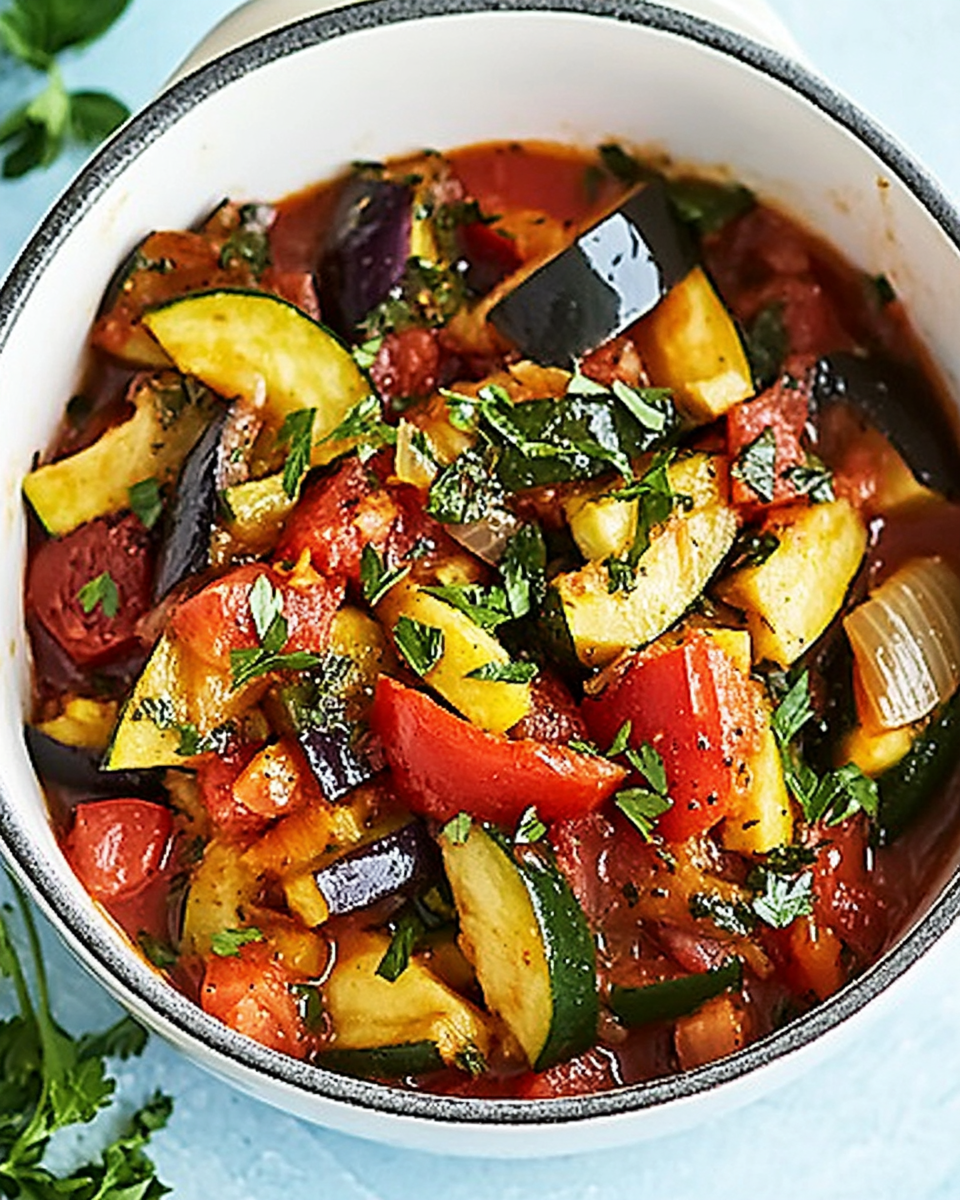This Summer Vegetable Ratatouille is a vibrant, healthy dish that combines fresh summer vegetables slow-cooked in a crockpot. It’s perfect as a light main course or a flavorful side, bursting with the taste of ripe tomatoes, zucchini, eggplant, and bell peppers infused with herbs and garlic.
FULL RECIPE
Ingredients
- 2 medium zucchinis, sliced
- 1 medium eggplant, diced
- 2 bell peppers (any color), chopped
- 4 ripe tomatoes, chopped
- 1 medium onion, diced
- 3 cloves garlic, minced
- 2 tablespoons olive oil
- 1 teaspoon dried thyme
- 1 teaspoon dried basil
- 1/2 teaspoon dried oregano
- Salt and pepper to taste
- Fresh parsley or basil for garnish (optional)
Directions
- Prepare all vegetables by washing and cutting them as described.
- In the crockpot, combine zucchini, eggplant, bell peppers, tomatoes, onion, and garlic.
- Drizzle olive oil over the vegetables and sprinkle thyme, basil, oregano, salt, and pepper.
- Stir gently to mix all ingredients evenly.
- Cover and cook on low for 6-8 hours or on high for 3-4 hours until vegetables are tender.
- Taste and adjust seasoning if needed.
- Garnish with fresh parsley or basil before serving if desired.
Nutritional Information
- Calories: 120
- Total Fat: 7g
- Saturated Fat: 1g
- Carbohydrates: 15g
- Fiber: 5g
- Sugars: 7g
- Protein: 3g
- Sodium: 150mg
History of Ratatouille
Ratatouille is a traditional French Provençal stewed vegetable dish that dates back to the 18th century. Originating from the region of Nice, it was initially a humble meal made by farmers using fresh, seasonal vegetables. The word “ratatouille” comes from the French verb “touiller,” meaning to stir or toss, reflecting the method of preparing and cooking the dish.
The Origins of Crockpot Cooking
The crockpot, also known as a slow cooker, became popular in the United States in the 1970s. It was created as a convenient way to prepare meals with minimal hands-on time, allowing flavors to develop slowly. Combining the rustic charm of ratatouille with the ease of crockpot cooking marries tradition with modern convenience.
Why Use a Crockpot for Ratatouille?
Using a crockpot for ratatouille lets the vegetables slowly meld together, intensifying their flavors while maintaining a tender texture. The slow cooking process enhances the natural sweetness of the vegetables without overcooking them. It also frees up time in the kitchen, making it a practical option for busy households.
The Benefits of Seasonal Vegetables
Ratatouille is a celebration of seasonal summer vegetables like zucchini, eggplant, tomatoes, and bell peppers. Using fresh, seasonal produce ensures the dish is bursting with vibrant flavors and rich nutrients. Seasonal vegetables are often more affordable and environmentally friendly, making this recipe both economical and sustainable.
Nutritional Benefits of Ratatouille
This dish is low in calories and fat while being high in fiber, vitamins, and antioxidants. The combination of colorful vegetables contributes to a well-rounded nutrient profile. It supports digestion, heart health, and offers anti-inflammatory benefits, making it an excellent choice for those seeking a wholesome diet.
Customizing Flavors with Herbs and Spices
Herbs such as thyme, basil, and oregano are classic to ratatouille, adding aromatic depth and complexity. These herbs complement the natural sweetness and earthiness of the vegetables. Fresh herbs can be added at the end for brightness, while dried herbs work well when slow cooking.
How to Choose the Best Vegetables
Selecting firm, fresh vegetables without blemishes ensures the best texture and flavor. Look for zucchinis and eggplants that are smooth and glossy, tomatoes that are ripe but not overly soft, and peppers with vibrant skin. Using organic produce can enhance the overall quality and taste of the dish.
Vegetarian and Vegan Friendly
Ratatouille is naturally vegetarian and vegan, making it a versatile dish for various dietary preferences. It can serve as a main course or side dish and pairs well with grains, legumes, or plant-based proteins for a complete meal.
Making Ratatouille Ahead of Time
Because the flavors deepen over time, ratatouille often tastes even better the next day. Preparing it in advance and storing it in the refrigerator allows the herbs and vegetables to meld beautifully. It’s an excellent option for meal prepping and easy weekday dinners.
Serving Suggestions
Ratatouille can be enjoyed on its own or as a side to grilled meats, roasted poultry, or fish. It also pairs wonderfully with crusty bread, rice, or pasta. Some enjoy it as a filling for savory crepes or as a topping for baked potatoes.
Storage and Reheating Tips
Store leftover ratatouille in an airtight container in the refrigerator for up to 4 days. Reheat gently on the stovetop or in the microwave to preserve the texture and flavor. Avoid overheating to prevent vegetables from becoming mushy.
The Role of Olive Oil
Olive oil is essential in ratatouille, providing richness and helping to bind the flavors. It also contributes healthy monounsaturated fats. Using high-quality extra virgin olive oil enhances the dish’s flavor profile and nutritional value.
Gluten-Free and Allergy-Friendly
This recipe is naturally gluten-free and free from common allergens like nuts and dairy. It can be safely enjoyed by those with gluten intolerance or allergies, offering a flavorful and nutritious option.
Pairing Ratatouille with Wine
Ratatouille pairs well with light to medium-bodied red wines such as Pinot Noir or Grenache. White wines with good acidity like Sauvignon Blanc also complement the fresh flavors of the vegetables. Wine pairing enhances the dining experience by balancing the dish’s earthy and sweet notes.
Ratatouille in Popular Culture
Thanks to the popular animated movie “Ratatouille,” the dish gained worldwide recognition. The film portrays ratatouille as a symbol of creativity and simplicity in cooking, inspiring many to explore this classic recipe in their own kitchens.
Adjusting the Recipe for Different Seasons
While ratatouille shines with summer vegetables, you can adapt it for other seasons by substituting ingredients. Winter squash, root vegetables, or even canned tomatoes can be used when fresh produce is limited, maintaining the comforting spirit of the dish.
Healthier Variations
For those seeking to reduce fat, olive oil amounts can be moderated or replaced with a lighter oil. Adding legumes like chickpeas or lentils can boost protein content. You can also experiment with different herbs and spices for varied flavor profiles without adding calories.
The Importance of Texture
Good ratatouille balances softness with slight bite to avoid becoming mushy. The crockpot’s slow cooking method requires careful timing to ensure vegetables retain some structure, which adds to the dish’s overall enjoyment.
Cultural Variations of Ratatouille
Similar vegetable stews exist in other Mediterranean cuisines, such as Italy’s caponata or Spain’s pisto. These dishes reflect the shared heritage of Mediterranean cooking while showcasing regional ingredients and flavor preferences.
Advertisement
Environmental Impact of Eating Plant-Based Meals
Dishes like ratatouille, made from fresh vegetables, have a lower carbon footprint compared to meat-based meals. Embracing more plant-based recipes supports sustainability and reduces the environmental impact of one’s diet.
Conclusion
Summer Vegetable Ratatouille made in a crockpot is an ideal way to enjoy fresh, seasonal vegetables with minimal effort. Its roots in Provençal tradition combined with modern convenience make it both comforting and practical. Nutrient-rich, flavorful, and versatile, this dish suits a variety of dietary needs and occasions. Whether served as a main or side, ratatouille brings a taste of the Mediterranean to your table and encourages mindful eating with wholesome ingredients. Its adaptability across seasons and cultural influences highlights the timeless appeal of this simple yet delicious vegetable medley.






